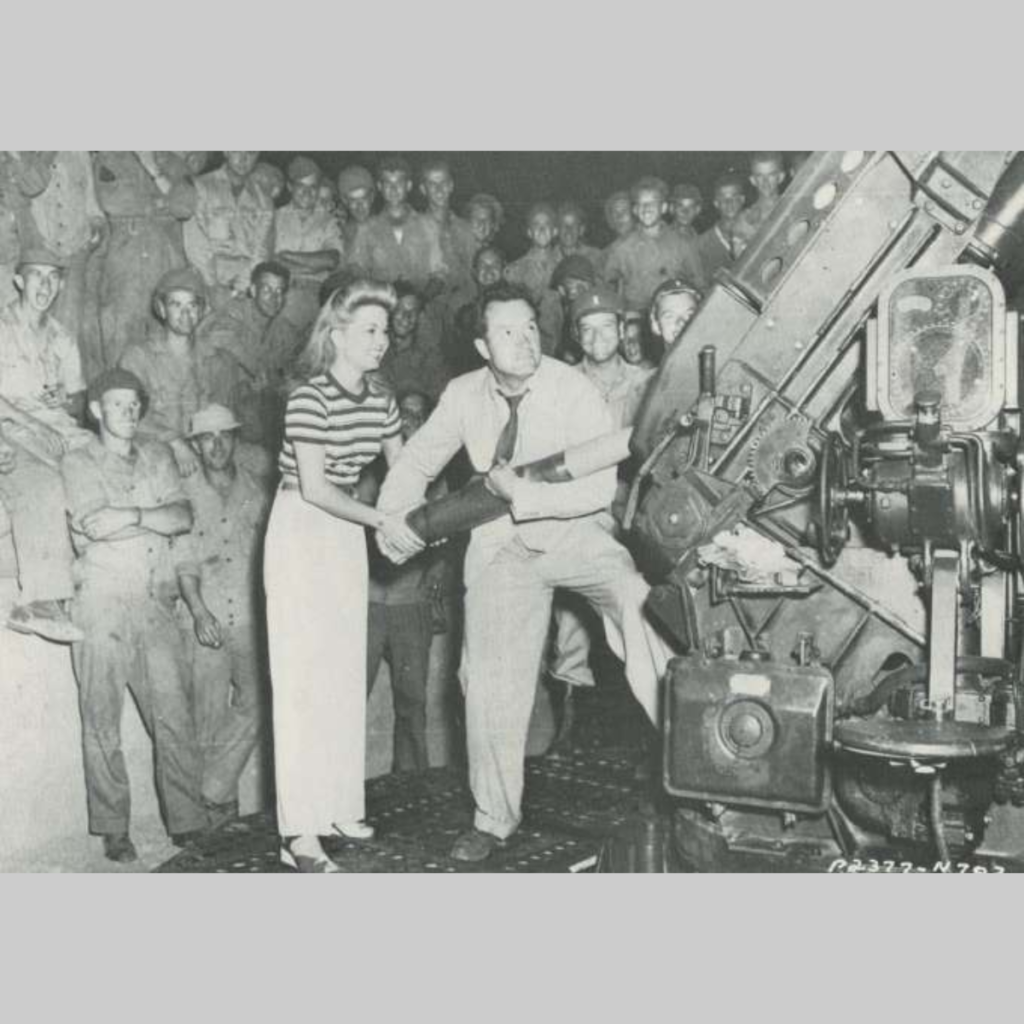
The 80-year career of Bob Hope, a giant of 20th Century show business history, is documented in the Bob Hope Collection. The archive highlights the iconic entertainer’s contributions to vaudeville, the Broadway theatre, radio, film, recordings and television, as well as his annual Bob Hope Christmas shows brought to the frontlines of the Second World War, the Korean War, the Vietnam War, Beirut and Operation Desert Shield. In support of the United Service Organization (USO), Hope entertained active-duty personnel in war zones for half a century, from 1941 to 1991. In wartime and peacetime, the Bob Hope Christmas tours were welcome and, in later years, sometime controversial diversions. Hope’s rapid-fire delivery crammed jokes into a performance, with an underlying witty skepticism and just enough brashness to set him apart from performers with gentler personalities. His showmanship resonated with millions of Americans during World War II and throughout the following decades in which the United States economy and military power expanded in influence around the world.

Bob Hope Loading an anti-aircraft gun in North Africa during World War II, 1943.
The 80-year career of Bob Hope, a giant of 20th Century show business history, is documented in the Bob Hope Collection. The archive highlights the iconic entertainer’s contributions to vaudeville, the Broadway theatre, radio, film, recordings and television, as well as his annual Bob Hope Christmas shows brought to the frontlines of the Second World War, the Korean War, the Vietnam War, Beirut and Operation Desert Shield. In support of the United Service Organization (USO), Hope entertained active-duty personnel in war zones for half a century, from 1941 to 1991. In wartime and peacetime, the Bob Hope Christmas tours were welcome and, in later years, sometime controversial diversions. Hope’s rapid-fire delivery crammed jokes into a performance, with an underlying witty skepticism and just enough brashness to set him apart from performers with gentler personalities. His showmanship resonated with millions of Americans during World War II and throughout the following decades in which the United States economy and military power expanded in influence around the world.

Bob Hope celebrates Christmas with troops, Bayonet Bowl, Korea. (1964)
Born Leslie Townes Hope in England in 1903, Bob Hope immigrated with his family to the United States at a young age. Over a long career in his adopted country, he became a household name, who could do it all, through his singing, dancing and legendary comedic timing with self-deprecating one-liners and commentary on world events. His top-rated radio and television shows and specials dominated broadcasting in the 20th Century and the programs were “can’t miss” events for decades. Hope was among the pioneers of today’s politically engaged mass-media celebrity culture, bringing formidable talent and exposure to the causes he supported. Roger Zoglin, Time Magazine’s senior entertainment editor, in his critically-acclaimed biography of Bob Hope named him “Performer of the Century” and he states that “the Bob Hope style and presentation helped establish modern stand-up comedy…He told his writers to read the papers — come up with lines about what’s happening in the world or what’s happening in Bob Hope’s life — his golf game or his friendship with [Bing] Crosby…This whole idea of having standup comedy week after week that actually drew on the outside world was, believe it or not, something new in the 1930s and 1940s. That, of course, is what every standup comedian does today…”

Bob Hope with King George, Queen Elizabeth, and Princess Margaret.
Bob Hope appeared in more than 70 short and feature films and for over 20 years, he was a top-ten fixture in box office polls, as a solo star, or most memorably teaming with Bing Crosby in a series of blockbuster “ROAD” pictures. The duo travelled on the Roads to Singapore, Zanzibar, Morocco, Utopia, Rio, Bali and Hong Kong between 1940 and 1962. In addition to his comedy output, Hope appeared in two memorable dramatic biopic roles. The first as vaudeville and Broadway showman Eddie Foy in “The Seven Little Foys,” in 1955 and in 1957, he portrayed Jimmy Walker, NYC’s corrupt mayor of the Roaring 20s, in BEAU JAMES. He was Hollywood’s and America’s favorite host especially for the annual Oscar telecast, which he emceed a record 19 times beginning in 1939, and he set the high standard for future hosts of the event.

Bob Hope and Bing Crosby in Road to Utopia, 1945.
Bob Hope was the foremost commentator on American life and times, in the 20th Century, and he was a friend to eleven Presidents who sought and enjoyed his good-natured political barbs aimed at both Republicans and Democrats. Bob Hope witnessed great changes in entertainment and culture and played a major role in the performing arts and world history. When Bob Hope died, at age 100, in 2003, this American institution was still front page news and his legacy is preserved at the University of Florida.

Signed photograph from U.S. President Dwight D. Eisenhower.
Bob Hope saved everything connected to his long career. Family mementos, awards, photographs, posters, handbills, costumes, fan letters and handmade gifts, recordings (various formats), newspaper and magazine clippings, scripts, signed letters and photos from world leaders and celebrities, ephemera and artifacts pertaining to his wife, Dolores, and their children, film posters and lobby cards, sheet music and concert orchestrations, scrapbooks and photo albums, golf clubs, golf bags and scorecards, comic books, biographies and autobiographies, jewelry, etc. make up the colorful, eclectic, historic Bob Hope Collection at the University of Florida.